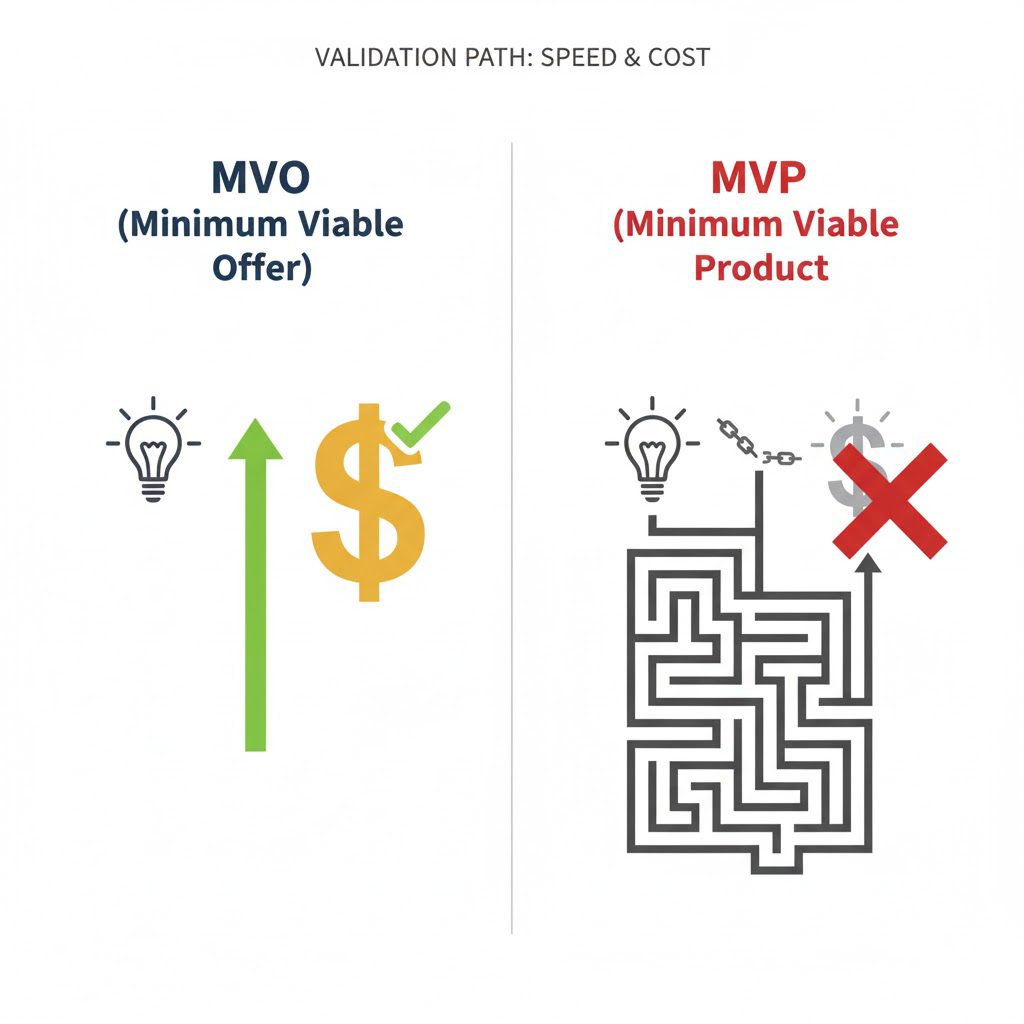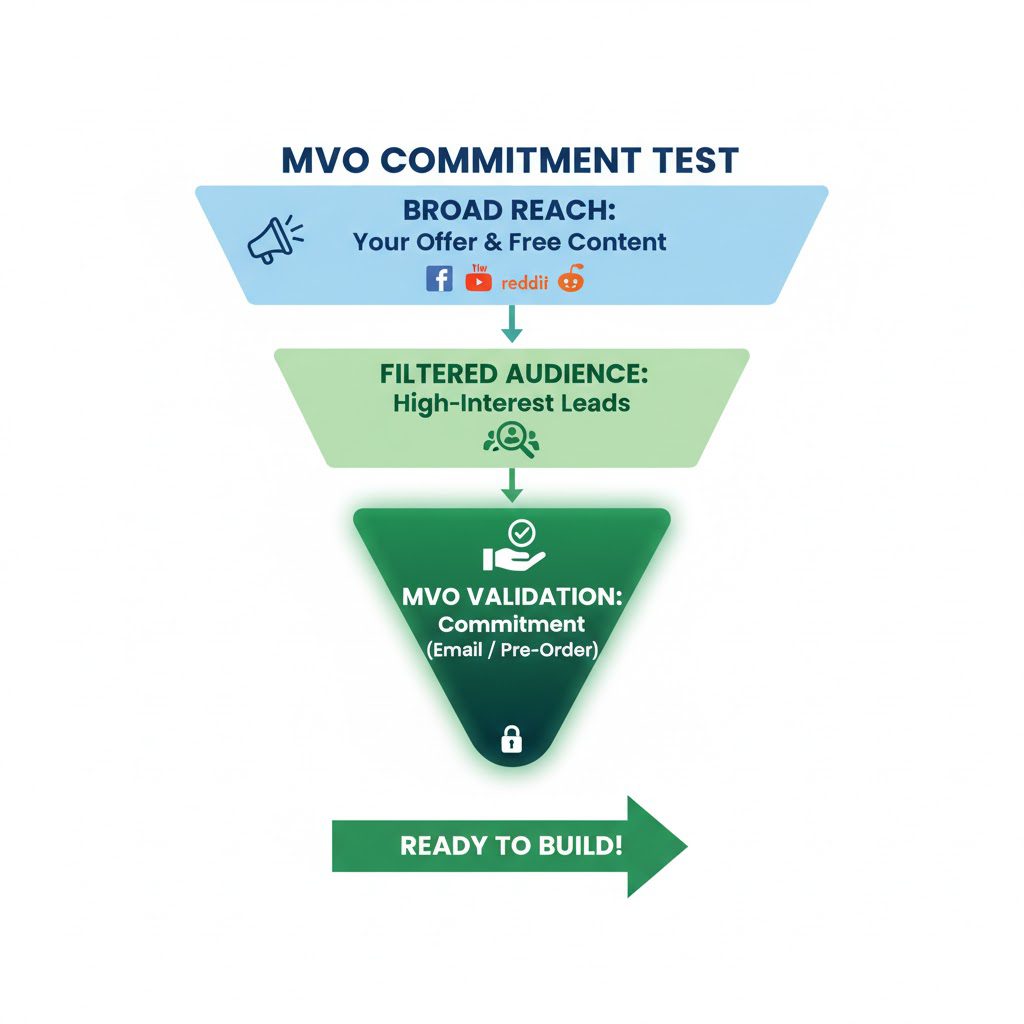Understanding MVO Validation for Solopreneurs
The MVO validation process (Minimum Viable Offer) is the critical first step in building a sustainable solo zero-budget business. It stands in stark contrast to the Minimum Viable Product (MVP), which requires time and often money to develop. The MVO, however, is simply the smallest, fastest way to test if your audience has a problem they will pay to solve—without you having to build anything yet. This concept is vital for the lean startup approach, a strategy popularized by leaders in the tech industry like those often featured on TechCrunch.
The MVO philosophy is the cornerstone of risk mitigation for any solo zero-budget business validation effort. You are not building a prototype (MVP); you are describing a solution and measuring pre-commitment. This is crucial because it ensures your time and effort are spent only on ideas the market has already signaled are valuable.
Why MVO, Not MVP? Essential for Solo Zero-Budget Business Validation

For the solo zero-budget business, time is your only currency. An MVP often leads to “analysis paralysis” or “feature creep,” where you spend weeks or months coding or designing something nobody ultimately wants. The MVO bypasses this development stage entirely. It asks, “Can I describe the solution, outline its benefits, and find people willing to commit before I spend a single hour or dollar building it?” You can find more detailed strategic thinking on this subject from renowned startup accelerators like Y Combinator.
This zero-cost approach allows you to run multiple tests simultaneously. You can validate three different ideas in the time it would take to build one basic MVP. This rapidly accelerates your ability to find a profitable niche.
7 Steps to Master the MVO Validation Process
The MVO validation process can be broken down into seven concrete, zero-cost steps designed to validate a business idea for free.
1. Define the Urgent Pain Point (Not the Solution)
Your MVO must solve one painful, specific problem. Don’t think: “I will build a finance tracking app.” Think: “I will help freelancers stop losing $500 a month in missed invoice payments.”
2. Craft the Single Offer (The Promise)
Define the singular deliverable (a 30-minute coaching call, a checklist, a template, etc.) and the guaranteed transformation. Example MVOs include: “The 10-Minute Cold Email Template that lands client replies” or “30-Day Trading Plan Checklist.”
3. Locate Your Target Audience (Free Channels)
Use free, targeted communities where your audience is already discussing their pain. This means posting on LinkedIn, targeted Reddit subreddits, or relevant Facebook groups.

4. The Commitment Test (The $0 Ask)
Instead of asking for a purchase, ask for an email address in exchange for “Early Access.” This tests commitment. A stronger test is asking for a small, refundable deposit or pre-order—this is the gold standard of validation.
5. Analyze the Signal-to-Noise Ratio
If 100 people see your offer, how many signed up or asked for more details? A strong signal means high commitment. A weak signal means your MVO needs refinement. This is the final step in solo zero-budget business validation before you build.
6. Refine and Reposition (Pivot Quickly)
If the response is weak, immediately change one element: the price, the target audience, or the promise. Do not get emotionally attached to your first idea. Pivot until the market demands the MVO.
7. Build When Validated (And Only Then)
Once you have 5-10 people committed, you can proceed to the next phase of the Roadmap. You are no longer guessing; you are building a product for proven demand.
Practical Minimum Viable Offer Examples to Inspire Your Launch
To illustrate this process, here are three high-impact minimum viable offer examples:
- The Single Template: A designer who offers one perfect Figma template for landing pages, charging $5 for immediate download instead of building an entire template library.
- The 30-Minute Consultation: An expert offers a highly niche consultation, such as “Fixing your LinkedIn Profile in 30 Minutes,” to validate demand for a full coaching program.
- The Premium Checklist: A writer creates a 5-page, high-value PDF checklist (e.g., “The Zero-Waste Pantry Setup Guide”) and tests it for $7 to validate interest in a larger e-book.
These minimum viable offer examples showcase that the offer’s value is in the transformation, not the complexity of the delivery.
